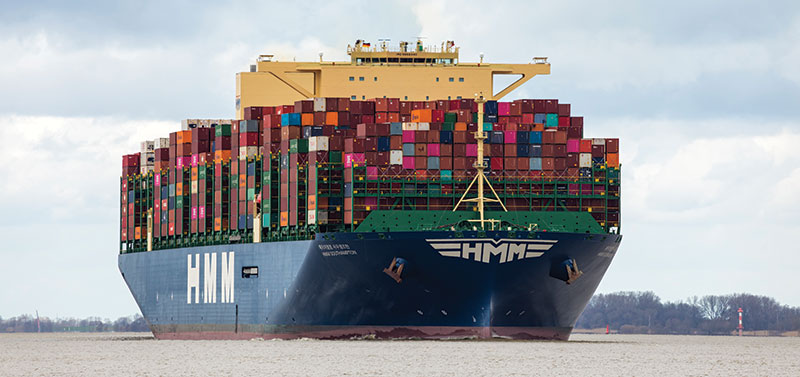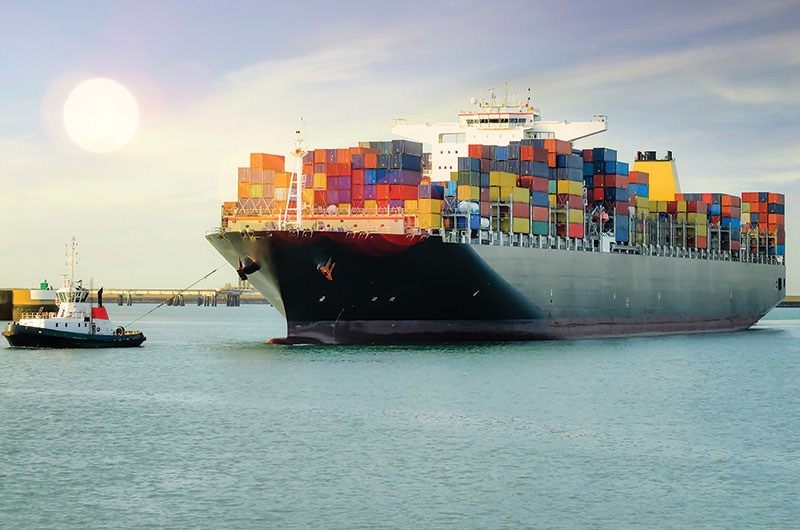Top 30 Ocean Carriers 2021: Pricing heads up as shippers fight for space
Shippers relying on maritime operators to get their goods to market have been slammed in recent months. Meanwhile container carriers are looking at 50%-plus percentage gains in revenue.
The top 10 carriers now operate 85% of global shipping capacity. Four groups—Maersk, MSC, CMA CGM and COSCO—control more than half of capacity (58%), and the top seven, including Hapag-Lloyd, ONE and Evergreen, control 78%. This base level of fleet concentration is then greatly enhanced by the existence of three vessel-sharing alliances on the mainline East-West trades—2M, the Ocean Alliance and THE Alliance—that count nine of the top 10 liner groups as members.
“The carriers are currently making huge profits as cargo demand exceeds available capacity,” says Stefan Verberckmoes, an Alphaliner analyst. “Shippers are bidding up against each other to obtain space, but all available tonnage is deployed and can’t be used efficiently as ships and containers get stuck in congested ports.”
According to Verberckmoes, several carriers have reported that due to the port bottlenecks, they currently need 20% more vessels and equipment to continue to carry the same amount of cargo. “Furthermore, this demand/capacity ratio is not expected to change before the next Lunar New Year, so we expect a tight market until the first quarter of 2022,” he says. “There’s low visibility for a rate forecast beyond that. The market will normalize at a moment in the future and rates will go down—but probably not any more to the very low levels of the past.”
At the same time, Alphaliner contends that there’s still room for new players to penetrate the Top 30 list if barriers to entry erode. “We currently see some smaller Chinese regional carriers venturing into East West trades,” says Verberckmoes. “They’re entirely tapping into the lucrative spot market that allows them to make huge profits with small ships. If rates go down eventually, it will be an unequal battle between these small carriers with 1,500 – 4,500 twenty-foot equivalent units [TEUs] and the global carriers with 13,000 – 24,000 TEUs.”
Alphaliner notes that medium-size carriers like Wan Hai and Zim have been among the fastest growing players on the Trans-Pacific. “Wan Hai is already spending lots of money on 13,000 TEU new buildings, which means that they probably will enter more trades with bigger ships,” says Verberckmoes.
At the same time, shippers should not expect more charter activity any time soon, as the current market is sold-out. Indeed, analysts see more “forward fixtures” with new charters arranged for ships whose current charter will not expire for the next several years.
Alphaliner’s Top 30 reflects further consolidation
|
Rank | Operator | TEU |
1 | 4,245,984 | |
2 | 4,131,039 | |
3 | 3,022,214 | |
4 | 2,973,641 | |
5 | 1,785,167 | |
6 | 1,584,015 | |
7 | 1,420,761 | |
8 | 826,948 | |
9 | 625,332 | |
10 | 426,927 | |
11 | 425,298 | |
12 | 265,356 | |
13 | 165,015 | |
14 | 148,044 | |
15 | 140,937 | |
16 | 140,313 | |
17 | 134,024 | |
18 | 133,600 | |
19 | 107,713 | |
20 | 106,966 | |
21 | 92,335 | |
22 | 72,256 | |
23 | 70,594 | |
24 | 67,750 | |
25 | 64,418 | |
26 | 63,994 | |
27 | 59,166 | |
28 | 56,033 | |
29 | 54,293 | |
30 | 47,262 |
Drama in two acts
For Verberckmoes, the global pandemic was a drama in two acts. First, the carriers had to deal with lower cargo demand. “They have managed capacity efficiently by taking ships and services out, thus preventing a free fall of rates,” he says. “Capacity management discipline is something they only recently learned.”
In the second act, the whole logistical chain is under severe stress. Carriers are making record profits, but also pay escalating charter rates, higher bunker fuel bills, and have to skip voyages as ships arrive late at the starting point of the rotation due to delays in previous ports.
If there’s a happy consequence to any of this, says Verberckmoes, shippers may expect more “greening” of the industry as it regroups in the future. “We see new initiatives such as e-methanol from Maersk, and more orders for LNG-fueled ships from Hapag-Lloyd and Zim,” he says. “Pressure from both shippers and authorities increases on the carriers to go green.”
Regulatory showdown
The fight over maritime container space and rates charged for ocean shipping service, which has been steadily growing more fractious throughout 2021, has suddenly spilled into the halls of Congress.
With ocean cargo shippers clamoring over market imbalance, claiming carriers are wrongly abusing their market position, a bi-partisan duo in the U.S. House has introduced a bill that would, if passed, implement a punch-list of reforms aimed at rebalancing the shipper-carrier dynamic and requiring more equitable treatment for containers of imports and exports.
The Ocean Shipping Reform Act of 2021, introduced last August, would beef up the Federal Maritime Commission’s (FMC) role in ensuring fair trade practices by attempting to reign in excessive detention and demurrage charges, block maritime carriers from declining U.S. exports without good reason, require carriers to report their import and export tonnage each quarter, and give FMC broader authority to take up investigations of abuses by carriers. It also stipulates that carriers “adhere to minimum service standards that meet public interest.”
Brian Glick, founder and CEO of Chain.io—a Cloud-based freight forwarder—is among the industry onlookers who contend that these reforms are more likely to do little to fix the issues plaguing shipper-carrier relationships in the near-term.
And longer-term, they could actually build more rigid walls between the two segments, rather than the bridges needed to truly solve the cascading crises that led to the current breakdown in the maritime shipping sector.
“The act’s pitfalls can’t be ignored,” says Glick, “and the maritime industry should take note of the need for greater use of data and integrations in solving the upheaval that’s been building over the past 18 months.”
Glick maintains that shippers need to align their TMS or ERP with independent data sources from ports, truckers, marine traffic, and AIS, as well as third-party sources. “If this regulation moves forward and shippers haven’t done this sort of groundwork, they will not be able to tell if they’re actually benefiting from the improvements and regulatory environment,” he concludes.
He also hopes that shippers will return to forging better relationships with carriers, rather than chasing the lowest rates when capacity is no longer an issue. “Both the pandemic and the subsequent e-commerce boom have taken all carriers and market watchers by surprise,” adds Verberckmoes. “But shippers who don’t begin to initiate carrier partnerships now will be out in the cold in the future.”
Recent news about Amazon and Home Depot pursuing deals to secure charters made headlines, but most U.S. importers and retailers have not circumvented the time-honored tradition of working with forwarders and middlemen.
It’s also encouraging to learn that CMA CGM is the first major carrier to place a ceiling on spot rates as peak season gets underway. Analysts say other major competitors will do likewise in an effort to win back shipper loyalty.
“CMA is the clear winner here,” says Jon Monroe, president of Monroe Consulting. “Whether carriers follow or not, they have set the stage for a more reasonable approach to the trade. It’s as if the carriers need to make all of their money this year.”
However, Monroe is telling shippers not to expect rates to take a large tumble. If the carriers do nothing more than keep the rates at the same level, 2022 will be another record year. “The only question to be answered is whether demand will continue to support the rates,” he says. “In the case that it doesn’t, expect carriers to go back to the initiation of blank sailings.”
But all of this might be academic when measuring the escalating expense of sourcing from China. According to the Drewry World Container Index, the cost of shipping a 40-foot container (FEU) from Shanghai to Los Angeles reached $11,569 last month—nearly eight times higher than pre-pandemic levels.

Long-term strategies
For other analysts, the current protracted situation means that short-term plans should be abandoned while waiting for the global crisis to get better on its own.
Descartes, a provider of Cloud-based services for global logistics, advices shippers to shift their movement of goods to less congested lanes, even if it takes longer to get goods to market.
“If shippers desire more predictable delivery, they should also evaluate product mix to only focus on their high velocity SKUs for the limited transportation capacity available,” says Chris Jones, executive vice president of industry and services at Descartes. “Furthermore, we advise them to determine the viability of potentially late shipments for short peak seasons—like Halloween—where missing by as much as a month could result in goods that will miss their sell season.”
Alfred Hille, director of product marketing, global trade intelligence at Descartes, notes that U.S. importers witnessed an overall ocean container throughput jump of up to 26% this year thanks to the efforts of 22 of the top 30 carriers.
“All of these vessel operators experienced growth in the double digits,” says Hille, “which demonstrates that high-growth carriers are the ones that can meet shipper needs in terms of the adoption of measures to mitigate the worst of the supply chain crunch, as well as manage shipper expectations in a strategic manner.”
For U.S. exporters, there’s a different story to tell, says Hille. “We’ve witnessed a realignment toward carriers that can be a guiding light to get goods to their destination on time and cost effectively,” he says. “In this situation, shippers will also gravitate toward carriers who are large enough to provide capacity at a reasonable rate, as well as flexible enough to be using more ports and alternative trade lanes.”
Descartes charted the top “countries of destinations” for U.S. exports and discovered that select markets in Asia—Vietnam, Thailand, India, and Malaysia—are all seeing significant annual percentile growth. “CMA has done particularly well, as has Yang Ming Marine Transport and Orient Overseas Container Line,” says Hille. “All share being heavily reliant on U.S./China Trade, however, and that’s been down by 14%.”













